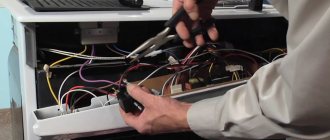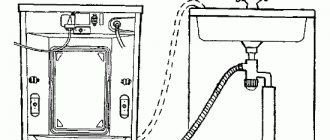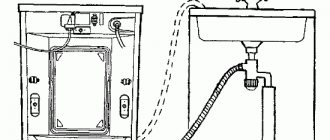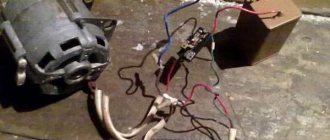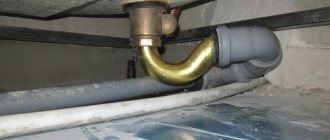What should you do if, after a certain period of proper operation, your machine or RCD in the electrical panel starts to trip when you turn on the washing machine?
Not everyone wants to immediately run to a service center, especially when the warranty has already expired. And transporting such large equipment is not an ordinary task.
In most cases, you can identify the breakdown and eliminate the cause yourself. The main thing is to know what to check and how.
Moreover, with a competent approach, it is possible to identify the cause of the shutdown even without special measuring instruments. There are several common symptoms and cases, let's look at them in order.
Signs and causes of failure
As a rule, the machine continues to wash even with cold water. To make sure that the heating device is malfunctioning, you need to understand the signs indicating a breakdown of the element. There are not so many of them:
- after the washing process, the laundry does not smell very pleasant;
- while the machine is operating, the glass on the loading hatch door does not heat up;
- things don't wash out.
The reasons for this problem include the following:
- Broken or shorted element. In such cases, the machine either does not work at all, or only works for a short time, because the remaining elements of the unit can easily become damaged and even burn out.
- Failure of the heating device circuit. In such situations, the heating element does not indicate any loss of performance, and the breakdown will be difficult to identify. But if the unit washes for a long time or periodically freezes, then the problem must be looked for in the break.
- Damage to the heating element relay. The device has a sensor responsible for the level of water intake. When the device is working, the water reaches the desired level, then the electronics receive a command to turn on the heater. It happens that the elements that control the amount of water become dirty during the period of operation. Therefore, you should clean the pressure switch and check the heating element sensor.
Often, users do not notice that the washing machine finishes the washing process untimely, or does not complete part of the program, and attribute such troubles to the electronics. And these are the first signals for help.
What does it look like and work like?
The heating element of an automatic washing machine (WMA) is a curved smooth tube with a conductive wire running inside it. The internal part is made of alloys with high electrical resistance. Changing the current parameters allows you to adjust the heating intensity .
Between the body and the working element there is a layer of material with high thermal conductivity. Between the contacts of the heater there is a socket for a temperature sensor, which determines the water temperature.
Some LG car models are equipped with heating elements that do not have an additional hole. In this case, the temperature sensor is located directly inside the tank.
To fix the heater more tightly in the seat, it may have a sealing collar or collar . This must be taken into account when choosing a part. Instead of a heater without a thermostat, you can install a heating element with space for a sensor, but the hole will require a special plug.
Where is the water heating element located?
If we consider different brands of machines (Indesit, Bosch, LG), then the heating element in each type of model can be located in different places, and it is most convenient to approach it either through the back panel or through the front.
But if you are not aware of this, you can still find it yourself:
- The back panel of the machine is inspected. If the lid is large, then the heating device is located behind it;
- The machine must be placed on its side and the bottom inspected. This may be how you detect the heater;
- The easiest way is to remove the back panel. If there is no heating element there, then it will be easy to install it in its place.
There is another option - use a flashlight to illuminate the inside of the drum of the machine. If you have good vision, you can determine the exact location of the heater.
Having found the heating element, you need to make sure that it is working. Note that for such a procedure there is no need to dismantle the element.
Pressostat malfunction
A pressure switch is a sensor that controls the water level in a machine tank. Its function is to send a signal to the electronic control module that the required volume of water has been collected, the inlet valve can be closed and heating can begin. Failure in its operation can be caused by hair, animal hair, lint from fabrics, which can clog the pressure switch tube, which will lead to a breakdown in communication with the control module. This will cause the machine to fill with water, but it will not heat up. Therefore, if the machine does not heat the water, you should try to clean the pressure switch tube by first removing it.
How to check the heating element of a washing machine
There are several ways:
- multimeter;
- a quick and easy way to check the body part;
- determination of performance without a device.
When you don't have a tester at hand, try performing the test without opening the case. By observing the behavior of the washing machine, you can easily determine that it is the heating device that has failed:
- The water does not heat up, but the washing process is carried out. On machines with screens, signals indicating this error will flash. If there is no display, pay attention to the flashing lights.
- The work process does not stop, the water heats up, but this takes much more time.
- The machine works, the water warms up, but when touching the body part, electric shocks are felt, and the automatic protection is periodically triggered.
When at least one of the indicated malfunctions is detected, there can be no doubt - the heating element is not working well. If you cannot check your unit with a tester, we recommend that you seek help from a specialist. He will confidently determine whether there is a need to replace the element.
There are several other ways in which you can organize an element check without the appropriate tools:
- As soon as dark spots appear on the body of the heater, a breakdown can be confidently diagnosed. Sometimes such points are hidden by scale; it needs to be cleaned in order to finally be convinced of your thoughts. Lemon juice will help you deal with scale;
- don't want to disassemble your machine? In this case, just watch the operation of the electric meter. Start the machine at maximum. When the meter spins faster, this means that the heating element is still working;
- Check the case for bulges, scratches and other damage. Their presence will confidently confirm that the heating device needs to be replaced;
- Electrical experts can look for an open circuit using a home-made test light.
Control module malfunctions
The reason for the lack of heating of water in the washing machine may be a malfunction of the electronic control system. Microcracks may appear in the electronic module, or more precisely on its board, which will break the contacts. The firmware may also crash, for example, as a result of a power surge. All this leads to malfunctions of the module, which may also be the reason why the washing machine stops heating the water. In certain cases, the control module must be repaired, and sometimes it needs to be completely replaced.
A breakdown of a washing machine, like all household appliances, can happen at any time. Various preventive measures will help delay the time of an unpleasant surprise from technology. They will help increase the service life of the machine and protect it from other possible malfunctions. Indeed, in addition to the situation considered, when the washing machine does not heat the water, this is far from the only reason why washing cannot be done. Preventive measures include fairly simple rules.
- Do not load the machine to capacity.
- Treat the device with care.
- Try to use high-quality detergents for washing.
- Use water filters and clean/change them regularly.
- Use anti-scale products and use washing machine cleaning products.
Following these rules will not take much effort and time, but it can significantly increase the trouble-free operation of the machine.
We call the device
Before checking the serviceability of the heating element, the washing machine must be disconnected from the electrical network. After this, the wiring is disconnected, the tester switch is set to 200 Ohms, and its probes are applied to the water heater terminals.
The result of your actions will be:
- a functional element will display on the device screen a value close to the calculated value;
- if the tester displays “one”, then there is a break inside and the heater will have to be replaced;
- when the value is “zero” or close to it, a short circuit has occurred. Ten is not suitable for further work.
Thermostat malfunction
A thermostat is a sensor that controls the water temperature. It can be located on the surface of the tank or in the heating element, depending on the model of the machine. In any case, it is involved in the process of heating water. Therefore, when the washing machine does not heat the water, the reason may lie precisely in it. You can also check the serviceability of the thermostat using a tester. To do this, you need to measure the resistance of the sensor. If the measurement reveals a malfunction, the sensor must be replaced with a similar one by contacting service.
Checking for breakdown
Even if the heating element spiral is in perfect order, this does not mean that everything is normal. Perhaps the dielectric inside has leaked into the body of the washing machine, and this already poses a danger to your body.
To organize a test of the heating element for breakdown, set the tester to the “buzzer” mode. After connecting the wires, the lamp on the device should light up and a squeaking sound should be heard.
Now we use the tester to take the heating element terminal and apply the second probe to the body. If there is no squeak, then everything is in perfect order. Otherwise, the heating device will definitely have to be replaced.
Calculation of indicators
Before checking the TEN, you need to know very clearly how to ring it and what data is considered correct.
To calculate resistance, you need to rely on:
- U is the voltage supplied to the heating element. In our household electrical networks, it is usually 220V.
- P – water heater power. You can find out this parameter by referring to the manual. If the manual doesn't say so, Google it and find your SM model.
Next, using a simple formula, as in a physics lesson in 7th grade, we calculate the resistance in Ohms:
R= U²/P.
If the resulting figure is displayed on the tester screen during testing, then the heating element is working.
So that you do not make mistakes in calculations using this formula, we will give a practical example.
Let's say the heater power is 1800 W. We substitute the values into the formula and get:
R=220²/1800=26.8 Ohm. As a result, the working heating element should show 26.8 Ohms. Remember this mark and you can start checking.
How is the resistance indicator of the heating element determined?
To check an element, it is not enough to know how and with what instruments this is done. It is necessary to have information about the value of its resistance. To begin with, it is recommended to calculate this value. To do this you will need the following information:
- Voltage supplied to the water heating element. As a rule, this indicator (U) is equal to 220 V. This voltage is present in the household electrical network of our apartments.
- The heater power indicator is R. It can be easily determined, you just need to look at the operating instructions. The second option - the power of the heating element can be checked on the Internet based on the model of the machine.
Having all the necessary information, we determine the resistance R using the special formula R=U²/P. The resulting resistance indicator is formed in the heater during operation. If the heating element is working properly, then the figure obtained by the formula will appear on the multimeter screen.
Heating element resistance measurement
The condition of the boiler can be assessed by comparing the actual values of the quantities with the standard figures obtained by calculations. To see how different the calculated electrical characteristics are from the indicators actually determined using a multimeter, knowledge from a school physics course is sufficient. To carry out the calculations you will need the following initial data:
- voltage in the socket for SMA – 220 V;
- washing machine heater power - the figure is taken from the technical data sheet of the household appliance;
- formula for calculating resistance: the ratio of the mains voltage to the second power to the rated power of the heating element.
Expert opinion
I work in the household appliance repair industry. Extensive experience in restoring washing machines and dishwashers.
Ask a Question
Calculations for a 1.8 kW heater: 220²/1800=26.8. Boiler 2000 W: 220²/2000=24.2. The dimension of the result in both examples is Ohm, which is the standard resistance value for heating elements of different powers. Such numbers on the screen of the measuring device confirm the serviceability of each of the heaters.
How to change the heating device?
We found the heating element and made sure that it should be replaced. First, disconnect all wires. To avoid confusion in the future, it is recommended to first record the order of their connection with a camera.
To remove the heating element, you need to unscrew the nut located in the middle part of the device. Now you need to pry the heater with a screwdriver and carefully remove it, rocking it in different directions. It is now recommended to immediately remove scale from other elements surrounding the water heater. The new heating element is carefully installed on special mounts. If you make a mistake, it will touch the tank during operation. All that remains is to connect the wires and assemble the machine to run it for testing.
Procedure for replacing an electric heater
Having made sure that the heating element does not work, they begin to dismantle it. During the disassembly process, it is recommended to photograph the main stages - this will make it easier to return the new heater to its original place. The procedure for replacing a burnt heating element is as follows:
- Unscrew the fastening nut - it is located in the center of the block and attracts the grounding wire.
- Press the released bolt inward, which passes through the rubber plug and rests its head against the pressure plate. In a compressed state, this design ensures the tightness of the tank at the point where the heating element enters it. When the bolt is released, the plug returns to its original shape, coinciding with the contour of the seat.
- Use a knife or screwdriver to carefully pry up the heating element so as not to damage the tank. Remove the heating element to replace it with a new one. Limescale deposits and rust complicate dismantling - you need to pull out the tubular structure one by one from each side, moving a fraction of a millimeter.
- Installing a new heating element is not difficult: the rubber retainer of the heater easily fits into the socket, where it is clamped with a fastening nut. Excessive force is inappropriate here - you cannot squeeze the sealant or break the thread.
Do you turn off the water tap after washing?
Oh yes! No.
Upon completion of the heater change, the CMA tank is checked for water leakage through the installation socket. After this, the power wires and grounding are connected. The previously removed panel is installed in its original place, the machine is connected to the electrical network and other communications, and a test run of the washing mode is performed.
You should not delay checking the serviceability of the water heater: a breakdown can develop into a major accident, which will entail the need for expensive repairs. Self-diagnosis is available to many home craftsmen, and the information provided here will help you replace a faulty heating element.
Expert advice
In order for the heating device to work as long as possible, you should provide proper care for the washing machine.
When performing repair work, be sure to disconnect the washing machine from the electrical network.
Many people recommend first removing the heater from the machine and then checking its functionality with instruments. But this is probably not necessary - the check can be easily carried out at the installation site. This will save time and avoid unnecessary work.
Reasons for failure of temperature sensors
The main causes of thermostat failures are:
- Frequent washes at high temperatures. Such temperature conditions affect the rapid wear of many parts of washing machines, and also negatively affect the quality of the fabrics of the washed items. Modern detergents are quite effective in removing stains even at low washing temperatures;
- Unstable voltage in the power supply network. Voltage fluctuations have a detrimental effect on any electronic components, and short circuits instantly damage them. To use a washing machine, it is best to install a separate electrical wiring line from the meter of your home.
- The wires must have a sufficient cross-section to avoid overheating of the insulation. The device must be grounded. For your own safety, you need to install an RCD (residual current device).
- How is blood washed off?
- How to wash membrane clothes
